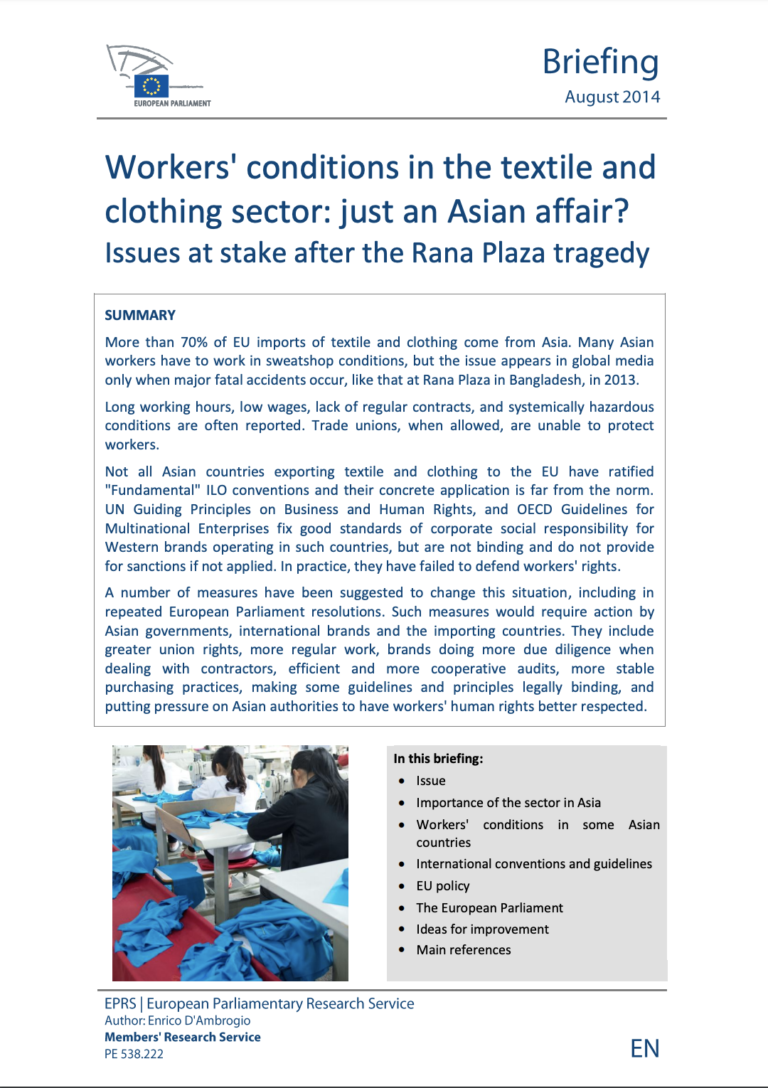Guiding Principles on Business and Human Rights
The UN Guiding Principles on Business and Human Rights are a set of guidelines for States and companies to prevent, address and remedy human rights abuses committed in business operations. child labour
Written by Enrico D’Ambrogio
More than 70% of EU imports of textile and clothing come from Asia. Many Asian workers have to work in sweatshop conditions, but the issue appears in global media only when major fatal accidents occur, like that at Rana Plaza in Bangladesh, in 2013.
Long working hours, low wages, lack of regular contracts, and systemically hazardous conditions are often reported. Trade unions, when allowed, are unable to protect workers.
Not all Asian countries exporting textile and clothing to the EU have ratified “Fundamental” ILO conventions and their concrete application is far from the norm. UN Guiding Principles on Business and Human Rights, and OECD Guidelines for Multinational Enterprises fix good standards of corporate social responsibility for Western brands operating in such countries, but are not binding and do not provide for sanctions if not applied. In practice, they have failed to defend workers’ rights.
A number of measures have been suggested to change this situation, including in repeated European Parliament resolutions. Such measures would require action by Asian governments, international brands and the importing countries. They include greater union rights, more regular work, brands doing more due diligence when dealing with contractors, efficient and more cooperative audits, more stable purchasing practices, making some guidelines and principles legally binding, and putting pressure on Asian authorities to have workers’ human rights better respected.

The UN Guiding Principles on Business and Human Rights are a set of guidelines for States and companies to prevent, address and remedy human rights abuses committed in business operations. child labour
The OECD Guidelines for Multinational Enterprises are recommendations addressed by governments to multinational enterprises operating in or from adhering countries. They provide non-binding principles and standards for responsible business conduct in a global context consistent with applicable laws and internationally...
Report launch: Wednesday, 11 May 2022 16:00-17:30 ICT (Cambodia/Vietnam) | 11:00-12:30 CEST (Austria) | 10:00-11:30 BST (UK) The number of women travelling from Cambodia to China for forced or arranged marriages has surged since 2016 and experienced a further spike...
An article by Garrett Brown MPH, CIH Corporate social responsibility (CSR) programs began in the early 1990s with the promise of eliminating dangerous and illegal “sweatshops” in the global supply chains of world-renown corporations selling ...Read More
In 2012, the Directive 2012/29/EU of the European Parliament and of the Council of 25 October 2012 establishing minimum standards on the rights, support and protection of victims of crime Union - the socalled Victims' Rights Directive -, that create...Read More
The data in this report represents signals and cases from January 1, 2017 through December 31, 2017 and is accurate as of July 11, 2018. Cases of trafficking may be ongoing or new information may be revealed to the National Hotline over time. Conseq...Read More